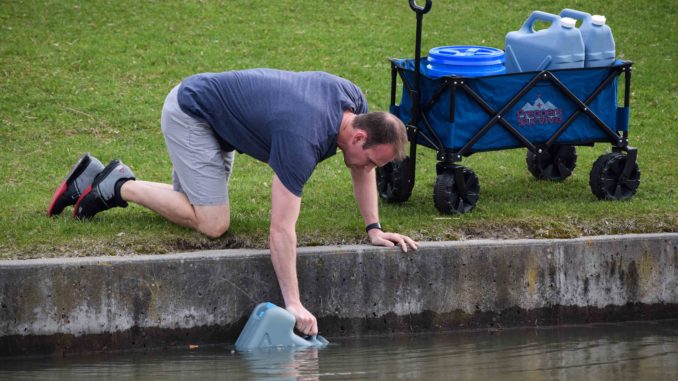
My husband was invited on a 3-day hiking trip with a brother-in-law. My husband was too thirsty to wait for some water to be boiled so he drank from a beautiful mountain river. He, of course, got very sick and had a pretty miserable next couple of days. Note: This was before I became a prepper and since then I’ve learned about survival water straws.
Do you really need emergency water supplies? Throughout history, there’s been a pattern of feast and famine. Times when there’s an abundance of water, food, commerce, and general peace. Then comes hard times, when food and other resource are scarce. This pattern happens continuously over the centuries and on every continent.
Did you know that 80% of illnesses in impoverished areas are caused by unclean drinking water? Access to clean drinking water is a resource that many of us in the United States take for granted. There are threats to our water supply include water supply terriorism, disasters (damage to water treatment plants), and the unknown effects of a pandemic.
Yes, I believe that every prepper should have emergency water supplies.
Clean water is such a valuable and vital resource. And one that many of us don’t think twice about. Just like I save money for a rainy day, I also save emergency water supplies that will ensure my family and I always have clean, safe water to drink.
6 Emergency Water Supplies You Should Have!
1. Water Storage Containers
For beginners, I recommend having at least a four day supply of drinking water for every member of the family. Each family member should have a ration of 1 gallon per day. So a family of 4 should have a minimum of 16 gallons of water storage. Having 4 cases of bottled water (35 pack) or 4 five-gallon water containers would cover it. Once your family is in the habit of rotating your water consistently (every 6-12 months), then work on a 2-week supply of water storage. Continue to increase it until you have reached enough water supplies for a month.
2. Water Purifier Filters
You don’t want to find yourself in a situation where you may be tempted to drink contaminated water because that is all that’s available. Trust me on this! Before you purchase a survival water filter, you should have a basic understanding of what a water filter is versus a purifier.
To be considered a water filter, the device needs to remove any random particle. For example, if it removes debris such as twigs or dirt, it’s a water filter. Not all filters will protect you from getting sick. There are 5 major hazards that you’ll want to be careful of: bacteria, parasites, viruses, chemicals, and heavy metals. It’s important to know what to look for in a survival water filter. The most common item that survival straw filters will remove is bacteria. Many will remove bacteria & parasites (protozoan cysts). These are the two most common threats that make people sick.
To be considered a water purifier, the device needs to remove at least 3 items: bacteria, parasites, and viruses. Water purifiers are usually much larger and expensive. It’s my recommendation to have a water purifier, preferably one that removes all 5 major water hazards. However, if the cost is an issue, start with a water filter that removes bacteria and parasites. It took me several years before I found a water purifier that was a good fit for my family.
I started with two water filter straws, a Lifestraw and a Sawyer. One for me and my husband (its’ important to to me not to spread germs so everyone in my family has their own water filter straw). I wanted to see which we would like better. The Sawyer was a clear winner. Since then I’ve added a couple more. They go with us on hikes and we also have some tucked away in our emergency water supplies bucket.
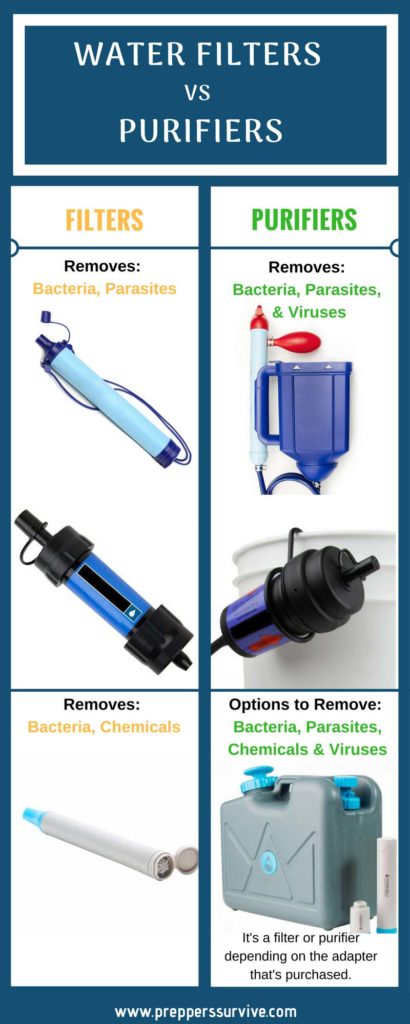
3. Water Collectors
In an emergency situation, you don’t want to contaminate your drinking water containers by collecting unclean water in them. Have some containers designated for water collecting and others designated for clean drinking water storage. Water gravity bags are great for collecting, carrying, and filtering water. They also fold up making them compact and easy to store. Jerry Cans are also a great option for collecting and carrying water. Water is not easy to transport. It’s heavy and sloshes around. It’s a good idea to know where the closest body of water is and to have a plan for collecting and transporting it. I have a wagon, 6-gallon containers, and water carrying sacks that make it easy to collect water from a nearby river.
4. Water Bottles with Measurement Markers
As a hiker, I’m frequently in situations where my water needs to be rationed. As a child who had to collect water, I was very mindful of not wasting any water and would have put every family member on rations, if my parents would have allowed it;) Many water bottles come with measurement markers so that water can be steadily rationed. These are a great resource if you ever need to survive off your water storage. They can help you determine how much water you’re drinking in a day. It also saves on washing cups when each family member has their own water bottle.
5. Water Test Kit
Tap water can become contaminated due to disaster, chemical spill or leakage, or terrorist attacks. Water storage can also go bad. Home water test kits are fairly cheap and provide peace of mind. There are simple tests that measure bacteria levels or more comprehensive tests for lead, pesticide, iron, copper, alkalinity, PH, hardness, chlorine, nitrates, and bacteria.
Read More About Rotating Water Storage Here…
6. Water Purifying Guide
Do you know how long to boil water to purify it? Do you know how many drops of bleach are need to disinfect one gallon of water? Did you know that you can tell which water born-related illness a person has based on their symptoms? The Prepper’s Water Survival Guide can explain all that and more. You shouldn’t count on the local internet to work and you don’t want to take a wild guess on how much bleach to add to purify water. A guide will be a vital resource in times of trouble.
Emergency Water Supplies Bucket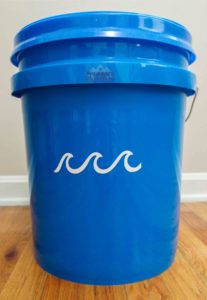
Keeping supplies organized is probably the number one problem for preppers. If you’re like me, it’s a real struggle at times. Over the years, as I continue to collect and check-off items on my Preppers Supplies Checklist, I’ve forgotten where I’ve stored some of my emergency water supplies. Items like extra water filters, emergency water guide, off-grid shower, emergency water tube liners, bacteria water test kits are in several places around my home. So I decided that color-coded five-gallon buckets with decal symbols are the best way to get organized. The cheapest place to find blue buckets is at Lowes for around $8.
Thanks for visiting Preppers Survive. Before you leave subscribe to our newsletter. If you enjoyed this article, please share it on your favorite social media.
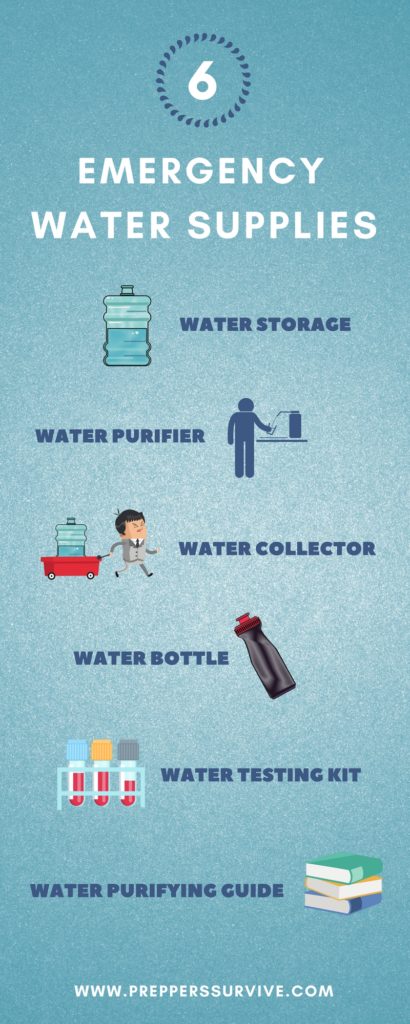


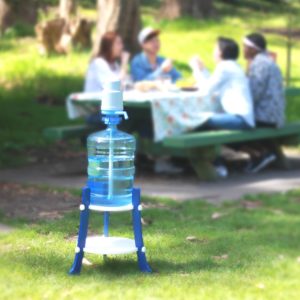
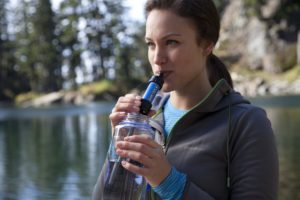
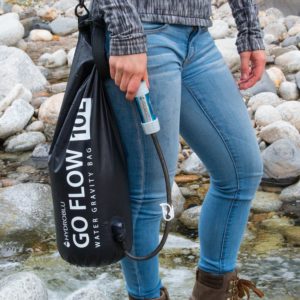
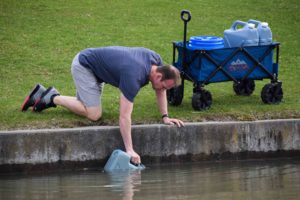
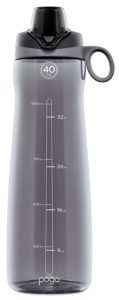
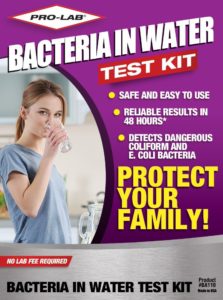
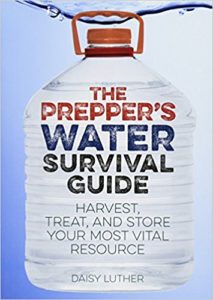
Remember the rule of 3
3 MINUTES without air
3 WEEKS without food
3 DAYS without water
CLEAN WATER !
72 hours without water is a crisis situation. Most water in the wild is not safe to drink and some of the purifiers make the water taste horrible.
I have also seen interesting devices to attach to your bathtub to collect water in an emergency situation. If you want to learn more, check out https://survivalistontap.com/prepare-for-a-heat-wave/